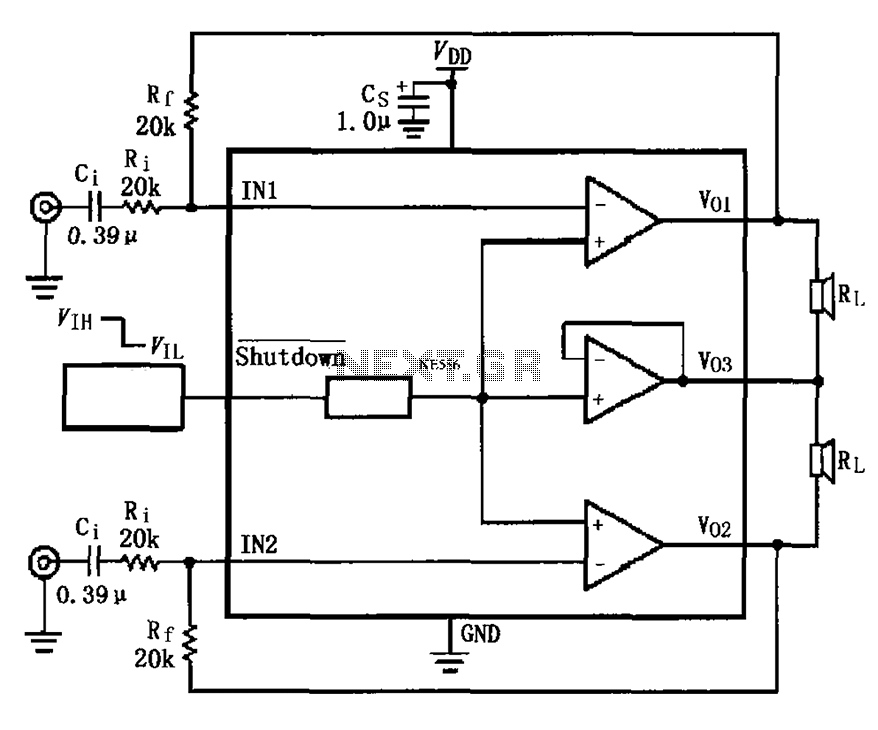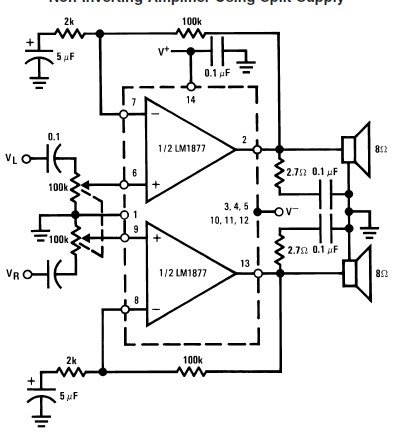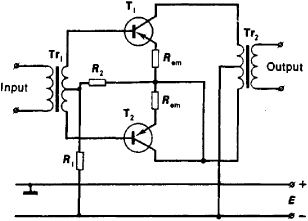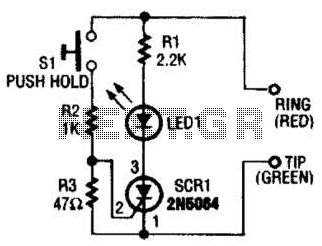
2x50w ics amplifier with stk4191
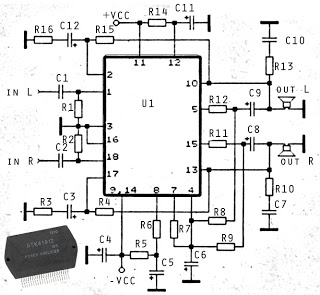
The circuit described is a stereo amplifier utilizing the STK4191 integrated circuit, providing an output power of 2 x 50 Watts at an 8-ohm impedance. Additionally, various other ICs in this series can be utilized, including the STK4101, STK4111, STK4121, STK5131, STK4141, STK4151, STK5161, STK4171, STK4181, and STK4191. The required supply voltage ranges from 12 Volts to 35 Volts DC.
The stereo amplifier circuit based on the STK4191 is designed to deliver high-quality audio amplification, suitable for various audio applications. The STK4191 is a power amplifier IC known for its efficiency and reliability, making it ideal for home audio systems, car audio, and other sound reinforcement applications. The output power of 2 x 50 Watts indicates that the amplifier can drive speakers effectively, providing adequate volume levels while maintaining sound clarity.
The circuit layout typically includes input connectors for audio signals, which are then fed into the amplifier stages. Capacitors are used to filter out unwanted noise and ensure that the audio signal remains clean. The output stage of the amplifier connects to the speakers, where the amplified signal is delivered.
Power supply considerations are crucial for the operation of this amplifier. A dual power supply configuration is often employed, with separate positive and negative voltage rails to accommodate the amplifier's requirements. The specified voltage range of 12 to 35 Volts DC allows for flexibility in power supply design, enabling the use of various transformer and rectifier arrangements to achieve the desired voltage levels.
Thermal management is also an important aspect of the design, as the amplifier can generate significant heat during operation. Heat sinks may be employed to dissipate heat away from the IC, ensuring reliable operation and preventing thermal shutdown. Additionally, proper layout techniques should be used to minimize parasitic inductance and capacitance, which can affect audio performance.
In summary, the STK4191 stereo amplifier circuit is a robust solution for audio amplification, offering versatility with compatible IC options and a wide supply voltage range, making it suitable for a variety of applications in the audio domain.The above is a stereo amplifier circuit based on IC STK4191 with 2 X 50Watt output power 8 ohm impedance. And besides that you can use some of the IC can also be applied in this series include the STK4101, 4111, 4121, 5131, 4141, 4151, 5161, 4171, 4181, and 4191.
Required supply voltage from 12 Volt to 35 Volt DC. 🔗 External reference
The stereo amplifier circuit based on the STK4191 is designed to deliver high-quality audio amplification, suitable for various audio applications. The STK4191 is a power amplifier IC known for its efficiency and reliability, making it ideal for home audio systems, car audio, and other sound reinforcement applications. The output power of 2 x 50 Watts indicates that the amplifier can drive speakers effectively, providing adequate volume levels while maintaining sound clarity.
The circuit layout typically includes input connectors for audio signals, which are then fed into the amplifier stages. Capacitors are used to filter out unwanted noise and ensure that the audio signal remains clean. The output stage of the amplifier connects to the speakers, where the amplified signal is delivered.
Power supply considerations are crucial for the operation of this amplifier. A dual power supply configuration is often employed, with separate positive and negative voltage rails to accommodate the amplifier's requirements. The specified voltage range of 12 to 35 Volts DC allows for flexibility in power supply design, enabling the use of various transformer and rectifier arrangements to achieve the desired voltage levels.
Thermal management is also an important aspect of the design, as the amplifier can generate significant heat during operation. Heat sinks may be employed to dissipate heat away from the IC, ensuring reliable operation and preventing thermal shutdown. Additionally, proper layout techniques should be used to minimize parasitic inductance and capacitance, which can affect audio performance.
In summary, the STK4191 stereo amplifier circuit is a robust solution for audio amplification, offering versatility with compatible IC options and a wide supply voltage range, making it suitable for a variety of applications in the audio domain.The above is a stereo amplifier circuit based on IC STK4191 with 2 X 50Watt output power 8 ohm impedance. And besides that you can use some of the IC can also be applied in this series include the STK4101, 4111, 4121, 5131, 4141, 4151, 5161, 4171, 4181, and 4191.
Required supply voltage from 12 Volt to 35 Volt DC. 🔗 External reference
